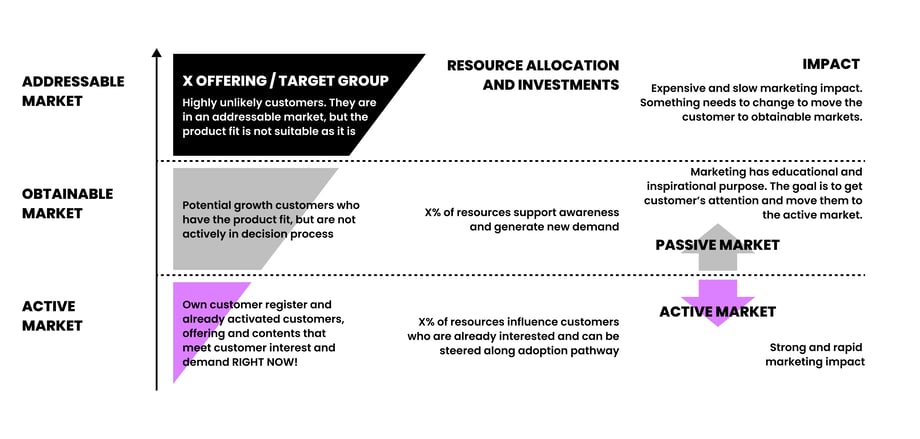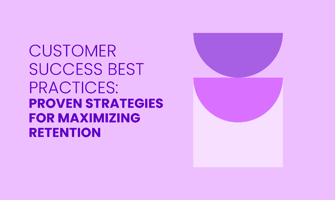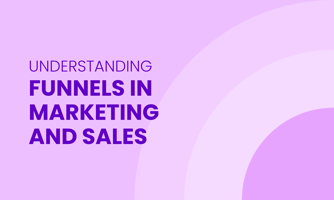Customer Success can affect a business's relationship with its customers. This guide shows how to...
Addressable, Obtainable and Active markets
The market activity has huge variation from one business sector to the next. In B2B some decisions are very long lasting, like investments to ERP, CRM, production facilities and real estate, production lines and machinery. They can also change the way a company operates: In case of outsourcing some functions the decision is done once and it is a big decision, but it continues as an ongoing retainer relationship. Customers in the active market represent only a fraction of obtainable or addressable markets.
In our daily lives the same is true, and we visit some categories very frequently. Most of us visit grocery stores multiple times a week, we visit restaurants and cafeterias quite often and make multiple decisions while visiting them. The same is true in B2B. There are types of companies that regularly buy in certain categories and others that never do it. This is about understanding the difference between overall market, addressable market, obtainable market and active market. If we can determine WHAT, HOW and WHY to offer WHEN, we have already improved the probability of profitable growth significantly.
The first thing to understand is to know, which types of companies we can NOT serve. Simply knowing which types of companies are out of the market gives us better focus. Those companies that can be served represent addressable market. When we calculate potential for addressable market, the number is going to be large, as it stands for 100% penetration with full portfolio in all relevant companies and doesn’t take into account market saturation and competitors customer relationship. This number is valuable because it gives us insights about total possibilities related to different industry types and help us make decisions about priorities. However, to make data more actionable, we need to dive deeper.
This picture represents how the market activity level influences marketing decisions and whether the impact of marketing should be fast or slower. See Figure 1:

Addressable market
Addressable market is about understanding how many customers out there could possibly buy our offering but need new decisions of conditions to become obtainable. Such companies may have eg. Decided to run certain operations in-house, which takes them out from outsourcing market. A retailer that doesn’t do eCommerce don’t need subscription management or parcel logistics. In case of eg. ICT infrastructure, they may have done significant decisions about focusing on certain ecosystems and offering families, which takes them out form others. Long service agreement can also effectively take companies away from obtainable markets for the length of contract term. In case we can discover and understand why customers make choices that take them away from obtainable market we can potentially innovate solutions to this and grow market share with those solutions.
Obtainable market
Obtainable market is about companies’ conditions and readiness. These companies have the product fit; they are conditioned to buy, and they represent actionable potential. In this target group our goal is to raise awareness of our offerings and capacity to help them succeed. This group of companies is the best for marketing driven demand generation which gives us signals about the company’s responsiveness to our messages. These companies can also be effectively addressed with both direct messaging to key decision makers and companywide in digital channels. What we learn from data, gives us directions for story telling. Data should help us define how do we tell our story to certain types of companies and how can we segment these companies for stronger messaging impact? When you find customers that resonate with your message strongly, it is possible to close new deals directly without heavy comparison and competition. The effective collaboration between sales and marketing can bring companies from obtainable market to decisions and help you win new market share.
Active Markets
Active markets represent companies that are making choices right now. These decision makers are looking for options, learning about different solutions’ benefits and learning about their suitability. The active consideration time can be anything from minutes to hours to months and years, depending on the type of the offering and company and choice the decision makers are doing. However, this is the moment when customer is most willing to meet you and learn about your solutions. This is the moment when you close deals or fail.
The studies show that most of the salespeoples’ time is addressed to customers who are not interested in buying and that has a direct impact on customer acquisition cost and growth. The availability of market data and signals is enabling us to approach the obtainable market effectively and steer resources in the right direction.
When we are making marketing investment decisions and setting goals for sales, we need to know what we are dealing with to optimize the value of investments in both short and long term. The market that is currently passive, but obtainable, can be educated and persuaded to consider new solutions and partners. Marketing should be working on creating communication programs and content to increase customer readiness and then continue with an active sales work taking things further or leverage more call-to-action centric approaches towards an active market.
Success Case example
In one client case that was about outsourcing, we were able to recognize what conditions made the customer a potential outsourcing customer. In outsourcing the company makes a rather significant decision about its own personnel and in such decisions status quo and inertia are rather strong influencers. There must be a very clear answer to the question WHY before anything can move forward. By interviewing management and sales and studying customer history I was able to recognize a pattern in how companies were conditioned to make a positive decision on outsourcing.
The source of insight was available in the financial data about the customers:
- Challenge: When a company grows more than xx% in a year, they suffer from lack of resources and they need to increase fixed costs in order to be able to keep up with the growth. It is likely that they fall behind regular delivery schedules and that will deteriorate customer trust and result in incidents and errors. They will also need to invest in technology and space, which will further grow the fixed cost dilemma and grow related risks.
Solution: In such a situation, outsourcing will retain jobs and relieve the company from growth bottlenecks. They will turn fixed costs into action-based costs that stay at the desired level no matter how much they grow. The customers stay happy and bottlenecks for growth are gone.
- Challenge: When a company’s sales decline more than xx% in a year, their fixed cost structure deteriorates profitability. The fixed costs don’t bend down and the cost of operations becomes too heavy compared to the turnover. These companies are faced with hard decisions that are likely to hurt the company’s employees' job security and break morale.
Solution: In such a situation outsourcing is about taking employees over in an outsourcing deal which will retain jobs and steer the excess of resources to other customers' needs. In case the customer company has its own real estate for the purpose, this change would enable liquidating the real estate and improving financial position to feed stability, development, and security. Again, moving from fixed costs to action-based costs will keep the company’s cost level at desired level regardless of what happens in volumes. This approach will also retain people’s jobs and is a win-win for everyone involved.
The clear insight was that shifts in turnover take customers from obtainable markets to active markets and it is then possible to bring them to new decisions. Recognizing this type of switch and value story combination can be game changing.
At the core of any segmentation should be value creation. The companies that benefit from similar solutions and have similar challenges and needs, form a segment that can be addressed with the same story. When I have been sparring with offering management, they absolutely love the idea of a goal portfolio/client or "Ideal Offering Profile" in any given segment. In each segment, we can define what a fully adopted offering and solution portfolio looks like and what is the level of ARPA (Average Revenue Per Account per annum) it generates. Having this type of goal and learning how companies adopt offerings and how different offerings deliver synergy, is effectively a story with clear and measurable value attached to it. This is an incredibly efficient approach to defining how we can help our customers succeed.
In the Management OS we are using AI and machine learning to recognize activity movements in the markets by combining internal and external data. The customer’s shift from addressable market to obtainable and active market is an important factor for resource allocation. At that time, we can recognize that we are able to help that company in their distress and show that together we are the smart player in the market capable of addressing hidden demand. It will also communicate strongly about professionalism and strengthen trust from the first meeting. These two reasons related to shifts in turnover explained their reasons to get interested were easy to turn into a story and value proposition that any given customer will appreciate.
INTERESTED IN DEMO, INTRODUCTION AND SPARRING?
Please, don't hesitate to open dialogue. We are happy to help. Leave your contacts here
Learn more:
What is Commercial Management Operating System?
Next generation of Datadriven intelligence by connecting internal and external data




